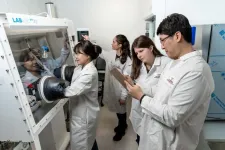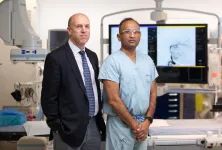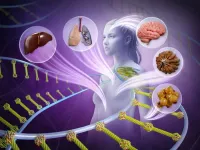(Press-News.org)
Modifying the physical characteristics of microscopic biomaterials to interact seamlessly with the body’s tissues could unlock safer and more effective cancer treatments, according to Virginia Tech researchers at the Fralin Biomedical Research Institute at VTC.
In an online review slated for the Feb. 10 issue of the Journal of Controlled Release, a research team led by DaeYong Lee, an assistant professor with the institute’s Cancer Research Center in Roanoke, highlighted how slight changes in therapeutic nanoparticles and biomaterials may one day improve treatment outcomes for patients.
The review article describes an underexplored area of cancer therapy: the role of physical properties, such as size, shape, and stiffness, in tuning the body’s immune responses.
“Modifying the physical characteristics of biomaterials is proving to be a powerful tool in controlling immune cell behavior,” said Lee, who is also a member of the Department of Biomedical Engineering and Mechanics of the Virginia Tech College of Engineering. “This approach allows us to precisely target and activate innate immune cells, such as macrophages and natural killer cells, which play a critical role in the fight against cancer.”
Lee’s expertise and contributions through high impact publications at the intersection of biomaterials science and cancer immunotherapy earned him an invitation to collaborate with his lab team and review the field in the Journal of Controlled Release article.
While early studies of biomaterial approaches have shown promise, many attempts failed in clinical trials, particularly for certain tumor types. To overcome these challenges, Lee’s team is shifting focus from solely optimizing chemical properties to fine-tuning the physical attributes of biomaterials to enhance their interactions with immune cells.
This work builds on a study published in Nature Biomedical Engineering in 2024, in which Lee and his colleagues engineered positively charged proteins to activate immune pathways.
The synthetic polypeptides worked by promoting the release of mitochondrial DNA, which in turn primed cancer-fighting T cells. In mouse models of advanced breast cancer, these engineered [LD1] polypeptides triggered robust antitumor immune responses, offering a potential new approach to cancer therapy.
“The design and optimization of biomaterials' physical properties is an underexplored area with significant potential,” said EunHye Kim, first author of the study and a postdoctoral associate in the Lee lab at the Fralin Biomedical Research Institute. “It is exciting to be at the forefront of this rapidly advancing field, driving discoveries that one day may help cancer patients.”
Despite these advances, Lee said that challenges remain. Translating innovations from the lab to clinical settings requires addressing scalability, manufacturing, and ensuring safety across diverse patient populations. Collaboration across disciplines — including materials science, immunology, and clinical research — will be essential to overcome these barriers and lay the groundwork for next-generation cancer treatments, Lee said.
Research assistant Katelyn Wahl and biomedical engineering graduate student Erica Guelfi also contributed to the study.
By focusing on the physical engineering of biomaterials, Lee’s lab is working to transform cancer therapy for patients who currently face limited treatment options.
“We are very fortunate to have recruited Dr. Lee to Virginia Tech from the MD Anderson Cancer Center in Houston as his work represents one of the essential approaches to next generation cancer therapeutics that we are emphasizing at our cancer research centers in Roanoke and in Washington, D.C.,” said Michael Friedlander, executive director of the research institute and Virginia Tech’s vice president for health science and technology. “His recruitment was made possible with the help of a transformational gift from the Red Gates Foundation that is helping Virginia Tech’s growth in cancer research.”
[LD1]Polypeptides
END
Research Highlights:
Neither a placebo procedure nor two different doses of transcranial brain stimulation, which send electrical signals through the skull, improved mobility recovery in stroke survivors receiving movement therapy.
Motor function was similar among survivors who received electrical brain stimulation combined with movement therapy or a placebo combined with movement therapy.
Note: The study featured in this news release is a research abstract. Abstracts presented at the American Heart Association’s ...
Killer whales are the only natural predator of baleen whales — those that have “baleen” in their mouths to sieve their plankton diet from the water. More solitary than toothed whales, baleen whales face predatory attacks from killer whales, especially mother and calf pairs. When attacked, some species fight back, while others choose flight.
But whale species also produce loud underwater songs. What stops killer whales from homing in on their calls and attacking them?
New research from the University of Washington finds some baleen whale species call at such deep frequencies that they’re completely undetectable ...
For many patients, getting ready to have surgery means getting their blood drawn, their heart rhythm checked, or having other tests in the weeks leading up to their operation.
But not all patients need all those tests -- especially if the results won’t change how their surgical team treats them or how well they do afterward.
Now, a new study shows how hospitals can focus the use of such tests on the patients who truly need them, while safely reducing unnecessary testing in others.
The result: less wasted money and resources for each test, and less wasted time for patients and clinical staff.
The study, published in JAMA ...
University of Calgary’s Hotchkiss Brain Institute researchers with the Calgary Stroke Program at Foothills Medical Centre revolutionized treatment for stroke with the ESCAPE Trial, proving that a clot retrieval procedure known as endovascular thrombectomy (EVT) can dramatically improve patient outcomes after an acute ischemic stroke caused by a blockage in a large-sized blood vessel.
Building on that knowledge, the team launched the ESCAPE-MeVO clinical trial to assess whether ischemic stroke patients with blockages in smaller medium-sized vessels could also benefit from EVT. Ischemic strokes are the most common form of stroke. The study, published ...
DALLAS, Feb. 6, 2025 — Physical activity positively impacts overall mental and physical wellness which is essential to help children reach their full potential[1]. That is why the American Heart Association, committed to changing the future of health, and the National Football League (NFL) are awarding 34 schools, at least one for each of the NFL teams, with $1,000 grants for physical activity equipment. Through support from the NFL, the NFL PLAY 60 grants are distributed by the American Heart Association annually to recognize those classrooms and ...
DETROIT — Physics-based computer simulations are essential tools for understanding the relationship between atomic-level interactions and physically observable properties of materials. It is from knowledge of these structure-property relationships that new materials can be designed with properties specifically tailored to address the problem of interest.
With the help of a new grant from the National Science Foundation (NSF), a team of Wayne State University College of Engineering researchers are developing new software to support computational materials design. Built on a 15-year collaborative effort, Jeffrey Potoff, Ph.D., chair ...
A University of Ottawa neuroscientist has led a Canadian research team to reveal important new insights into the activation dynamics of neural stem cells (NSCs). These are the stem cells that build our central nervous systems and the self-renewing.
The collaborative team led by the University of Ottawa’s Dr. Armen Saghatelyan aimed to shed light on how neural stem cells integrate a multitude of signals from different cell types in the brain – and how they decode these signals.
These are big questions because how NSCs react to signals in their cellular environment controls whether they remain in their ...
Despite new medication, cystic fibrosis often leads to permanent lung damage. Working with an international team, researchers from the Technical University of Munich (TUM) have discovered that the disease causes changes in the immune system early in life, presumably even in newborns. These changes lead to frequent inflammation and are not affected by drugs targeting the altered mucus production.
Cystic fibrosis is caused by hereditary genetic mutations that impair or halt the production of the CFTR protein. The respiratory tract ...
UNIVERSITY PARK, Pa. — A biomaterial that can mimic certain behaviors within biological tissues could advance regenerative medicine, disease modeling, soft robotics and more, according to researchers at Penn State.
Materials created up to this point to mimic tissues and extracellular matrices (ECMs) — the body’s biological scaffolding of proteins and molecules that surrounds and supports tissues and cells — have all had limitations that hamper their practical applications, according to the team. To overcome some of those limitations, ...
In 2017, a tragic incident unfolded in a Nevada hospital. A woman, admitted for pneumonia, tragically succumbed to multiple organ failure and sepsis. The culprit? A strain of bacteria that had developed resistance to a staggering 26 different antibiotics. These superbugs, or antibiotic-resistant bacteria, stand as one of the most pressing public health threats globally.
Joining the effort to fight these deadly pathogens, researchers at Texas A&M have now shown that curcumin, the compound that gives turmeric its characteristic bright yellow color, can potentially be used to reduce antibiotic resistance.
The ...


